The forum in Rome was the very heart of the ancient Roman Empire, a testament today to her former greatness. It was first paved in the late 7th century BC and drained of stagnant waters a few decades later by the Etruscan king Servius Tullius. It began as a rectangular square of several structures, including temples, but was eventually divided into three parts: the Comitium (political center), the Regia (religious center), and the Forum proper (commercial center). As the population of Rome grew, the forum was continually expanded, with new emperors building their own structures.
Roman Forum
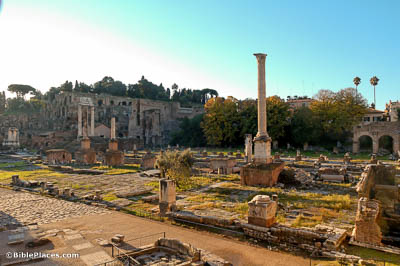
Brief History
Arch of Severus
Built in AD 203, this arch commemorates the campaigns of Severus and his sons (Geta and Caracalla) in Parthia (modern Iran), as depicted on the arch’s reliefs. The triple archway stands 74 feet (23 m) high, 80 feet (25 m) wide, and 38 feet (11.85 m) deep, and is constructed entirely of white marble. The dedicatory inscription originally had gilded bronze letters, but the bronze was taken, and Geta’s name was replaced with Caracalla’s after Caracalla murdered Geta in 212. The arch was restored in the late 20th century.
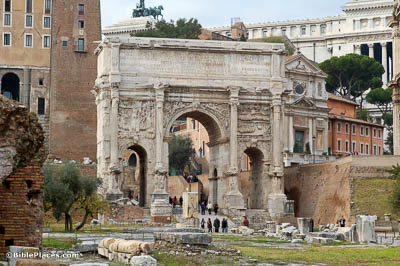
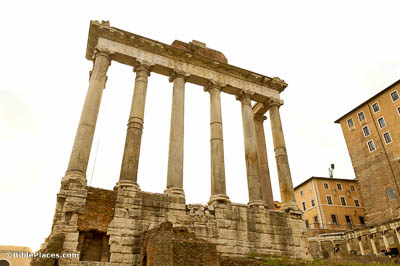
Temple of Saturn
One of the oldest temples in Rome, the Temple of Saturn was first built in 497 BC in honor of Italy’s fabled god-king. It served as the State treasury and the site of an annual festival, called the Saturnalia, held on December 17. For the Saturnalia, slaves would be free to do as they wished and gifts were exchanged; the festival later came to be associated with New Year’s Day and Christmas. Lucius Munatius Plancus reconstructed the Temple of Saturn in 42 BC, and it was again restored in AD 283 and 400, following fires. After the latter reconstruction, an inscription was added to the architrave, reading: “Destroyed by fire, restored by the Senate and People of Rome.”
Temple of Mars Ultor
This temple was dedicated to Mars Ultor (the “Avenger”) by Octavian in 42 BC, following the battle of Philippi, in which Caesar’s assassins, Cassius and Brutus, were defeated and Caesar was “avenged.” Many relics from ancient Rome were stored within the temple, and an underground chamber may have served as a treasury. The building was central to foreign policy and closely associated with the military. It was here that the Senate met to discuss the prospect of war and boys coming of age were acknowledged. The structure took more than two decades to build, but it was well preserved into the Middle Ages; since then it has fallen into significant disrepair.
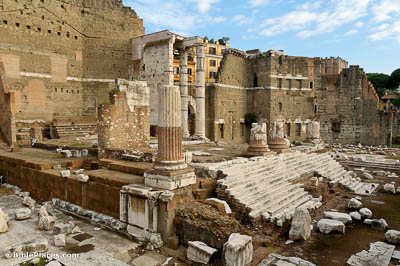
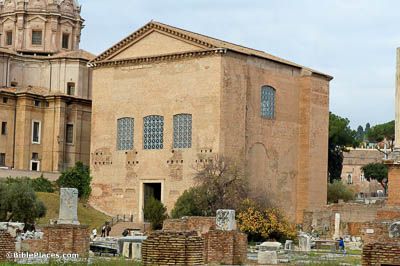
Julia Curia
Julius Caesar rebuilt Sulla’s (80 BC) earlier building on this site when it was destroyed by a fire in 44 BC. Upon Julius’s assassination Augustus finished the work and dedicated the structure to Julius in 29 BC. He also moved the meeting place of the Senate to this location. The Julia Curia included a statue of the goddess Victory. The building which is visible today dates to Domitian, a structure Diocletian restored after a fire in AD 283, and was used as a church in the 7th century. In the early 20th century, Alfonso Bartoli returned it to its condition under Diocletian.
Basilica of Maxentius
The Basilica of Maxentius has also been called the Basilica of Constantine and the Basilica Nova. Maxentius began construction on it, but when Constantine defeated him in AD 312, Constantine finished it, adding a portico and a second apse. The structure likely served as the meeting place for the tribunal. Its arches are enormous, measuring 66 feet (20.5 m) wide, 56 feet (17.5 m) deep, and 78 feet (24.5 m) high. Impressive and skillful, the Basilica of Maxentius was inspiring to Renaissance artists like Michelangelo, particularly during his painting of the dome of St Peter’s.
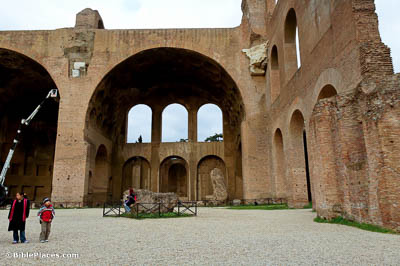
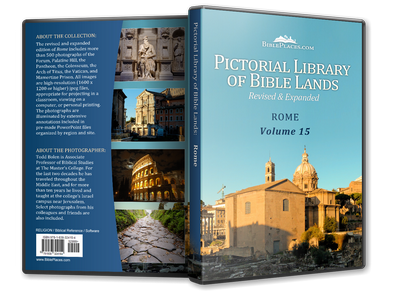
Download all of our Rome photos!
$24.00 $29.99 FREE SHIPPING
Related Websites
Roman Forum (History.com). A succinct summary of the Forum’s basic history and major features.
Forum Romanum (Khan Academy). A longer and nicely-illustrated overview. The other lessons are also worth looking at for their information about Roman art and architecture in general.
An Overview of Buildings in the Roman Forum (ThoughtCo.). This list is not exhaustive, but it does offer helpful information on some of the major structures.
The Roman Forum (James Grout). This page offers a basic map of the site and links to several pages dedicated to individual structures in the Forum.
Arch of Septimius Severus (Livius). This page offers extensive information about the arch, including photos and descriptions of each relief.